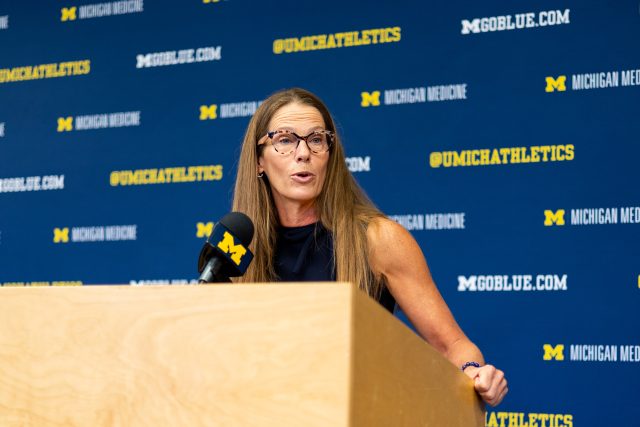[ad_1]
This past offseason, the Michigan women’s basketball team lost over half of its minutes played and scoring production to the transfer portal. Six players left the Wolverines’ program, with five going to Power Four schools.
Then-junior guard Laila Phelia highlighted the mass exodus from Michigan. After being named to the All-Big Ten first team, averaging over 16 points and becoming the 31st Wolverine in program history to reach the 1,000-point threshold, she opted to take her talents to Texas for her final year of eligibility. Michigan also lost frequent starters in forwards Cameron Williams and Chyra Evans, along with key contributors in forwards Taylor Williams and Taylor Woodson.
“I was crushed,” Wolverines coach Kim Barnes Arico said Tuesday at Michigan media day. “I was really hurt. And I think everybody in that position would be.”
However, losing players to the portal isn’t unique to Michigan. Several programs around the country have experienced similar offseasons, as the transfer portal and new name, image and likeness rules have altered the landscape of college basketball. Over 1,300 women’s basketball players hit the portal this past offseason, and nearly half of Power Four schools had at least four players transfer out.
“I had a bunch of coaches reach out to me … they said, ‘We know it hurts, we’ve been through it already … you know you’re going to be okay,’ ” Barnes Arico said. “The landscape has certainly changed.”
As a result of the Wolverines’ tumultuous offseason, Barnes Arico has replenished her program with fresh faces, including five freshmen who make up the highest-rated recruiting class in program history. Adjusting with the times, Barnes Arico also added three transfers, yet only one with Power Four experience.
Recently, programs around the country are relying more on the transfer portal to build their teams. In particular, top teams bolster already-strong rosters with experienced, proven talent they know can contribute immediately.
Going against the grain, Barnes Arico still favors a more traditional approach. She values player development, relationships and maintaining a strong culture, components of a successful program that are largely dependent on recruiting high school players.
“We consider ourselves program builders,” Barnes Arico said. “What we do may be different than a lot of other programs. We’re not a program that’s based on the transfer portal. … That’s not the kind of culture of our university. It’s not the culture of our program. We really pride ourselves on building something.”
However, Barnes Arico understands the importance of adapting to the constantly changing landscape of college basketball, and that means capitalizing on the transfer portal in addition to recruiting out of high school. Michigan added three this offseason after bringing in three the year before, but just two of the six total had previous Power Four experience.
“Those questions (about the sport) will need to be answered so that we can compete with the best in the country,” Barnes Arico said. “That’s always the goal for Michigan athletics, to be in a position to compete against the best.”
Unfortunately for the Wolverines, they got little proven production back in the portal despite losing most of theirs. To make up for this, they’ll rely on their few returnees and a group of highly rated freshmen to carry the load this year.
Moving forward, Michigan will still prioritize bringing in talent through the high school ranks. But to thrive in these tumultuous times, the Wolverines need to have more success in the transfer portal — both at retaining and bringing in top talent.
Related articles
[ad_2]
Source link











